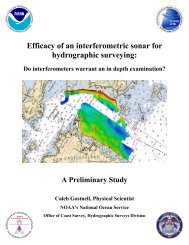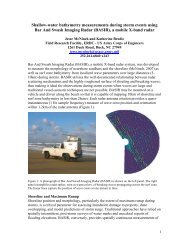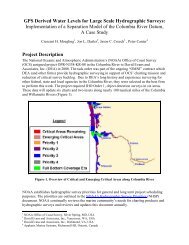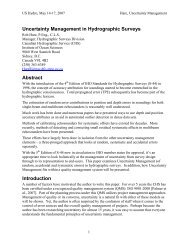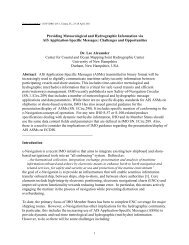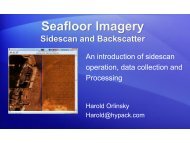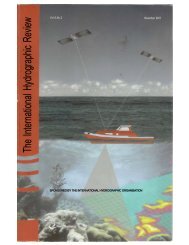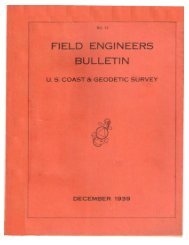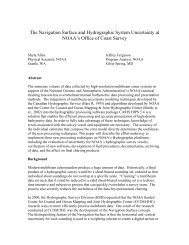High-Resolution Acoustic Multibeam Surveys for Bridge Assessment
High-Resolution Acoustic Multibeam Surveys for Bridge Assessment
High-Resolution Acoustic Multibeam Surveys for Bridge Assessment
Create successful ePaper yourself
Turn your PDF publications into a flip-book with our unique Google optimized e-Paper software.
The difficulties associated with bottom detection around the vertical bridge structures, usually results ina noisy acoustic dataset around these areas. Though some of these problems can be minimized bycareful attention to sonar tuning during data acquisition, it is inevitable that careful manual cleaning willbe required in the areas around most of the underwater supports. Because these challenging areas willhave been covered by multiple survey lines along multiple orientations, it is important that theindividual lines be edited carefully prior to examination within an area‐based editor. Because theposition tolerances are very tight in the areas around the vertical surfaces, if potential position issuescannot be resolved <strong>for</strong> a specific line, then that line should be excluded from the subsequent editingprocess. In the end, careful manual cleaning within an area–based editor will be required to createdatasets that accurately reflect the vertical structure.MULTIBEAM SURVEYS FOR UNDERWATER BRIDGE INSPECTIONSThe Federal <strong>High</strong>way Administration’s (FHA) bridge inspection requirements specify that all bridges withany underwater supports must be inspected at no greater than a five year interval. Most existing bridgeinspection techniques are focused on structural assessment and rely primarily on diver visual orsometimes sector‐scanning sonar techniques. Many of these same inspection programs have alsoincluded some type of initial single‐beam fathometric survey requirement, though the re‐surveyrequirements seem to vary a great deal by state. Due to certain environmental conditions (e.g., deepwater, strong currents, and murky water), underwater inspections of some bridges can be difficult andsometimes dangerous. In addition, the existing structural assessment methods, like visual inspection orsector‐scanning sonar, are not well‐suited <strong>for</strong> making an accurate or complete quantitative assessmentof scour around all of the structural supports. Over the years, scour around the structural supports hasproven to be the primary cause <strong>for</strong> most major bridge failures. Though it will not replace the need <strong>for</strong>periodic “hands‐on” structural evaluations through either diver visual methods or scanning sonartechniques, the multibeam survey approach offers a number of unique benefits as a bridge assessmenttool. The following section provides an overview of the methods and results <strong>for</strong> a recent bridgeinspection multibeam survey project.Representative <strong>Multibeam</strong> <strong>Bridge</strong> Inspection ProjectThe Maine Department of Transportation (ME DOT) has one of the more robust underwater bridgeinspection programs in the nation, as part of its ef<strong>for</strong>t to ensure the structural integrity of the state’sbridges and comply with the FHA’s bridge inspection requirements. ME DOT currently has a 12‐personprofessional dive team that conducts bridge inspections at intervals of no greater than five‐years <strong>for</strong>each of the state’s bridges that rely on underwater structural support. Due to strong currents andrestricted visibility, underwater visual inspections of certain bridges ‐ including three that span theKennebec River in the towns of Bath and Richmond, Maine ‐ can be particularly difficult <strong>for</strong> divers tomanage. In light of these challenges and the safety risks posed <strong>for</strong> its divers, the ME DOT recently choseto use multibeam bathymetry to meet their underwater bridge inspection requirements.Substructure, Inc. of Portsmouth, NH was selected by ME DOT to conduct high‐resolution multibeamsurveys of the Bath and Richmond bridges, utilizing the company’s survey vessel Orion. Though thesebridges had been in place <strong>for</strong> many years, what was deemed to be the initial “baseline” surveys of theBath and Richmond bridges were conducted by Substructure in June 2009 during an unusually high flowperiod on the Kennebec River. In July 2010, Substructure conducted an additional baseline survey of theSheepscot River Railroad <strong>Bridge</strong>, and also returned to the Richmond <strong>Bridge</strong> to conduct a follow‐up“current‐conditions” survey (Figure 2). This re‐survey of the Richmond <strong>Bridge</strong> was completed to obtain5



